Food Bill: A Vote-winner and Budget-buster

Plans to expand the multi-billion dollar food subsidy programme are a likely vote-winner for the ruling Congress party as it heads into key local elections in 2012, but could worsen strained finances as a flagging economy crimps revenue.
The Food Security Bill, introduced in parliament on Thursday and expected to win easy approval, would guarantee cut-price grains to 63.5 percent of India's 1.2 billion people, adding as much as $7.5 billion to New Delhi's subsidy burden.
India is already unlikely to meet its target to cut its fiscal deficit to 4.6 percent of GDP in the fiscal year that ends in March, as slower-than-expected economic growth crimps tax collections and poor markets prevent India from selling stakes in government companies.
Where will the money come from? asked Ashok Gulati, chairman of the Commission for Agricultural Costs and Prices, in a Reuters interview.
There is a limit beyond which you cannot spend. Oil, food, and fertiliser subsidies are already too high, he said.
New Delhi's fiscal projections were based on economic growth in the current fiscal year of nine percent. Latest figures show it slid to 6.9 percent in July to September and it has been under eight percent since the start of 2011.
Some private economists believe the economy will struggle to grow at seven percent in 2011/12.
Government revenue through October was only 45.5 percent of the full year target, compared with 65.6 percent a year earlier.
With growth slowing and consequently revenues not matching up to expectations, additional expenditures will keep the government away from the path of fiscal consolidation, Kotak Mahindra Bank wrote in a note this week.
The bank expects India's fiscal deficit to hit 5.7 percent of GDP this fiscal year and 5.8 percent the next.
Worries over a further increase in government borrowing in this fiscal year beyond its budgeted 4.7 trillion rupees -- which is already more than originally targeted -- has weighed on bond markets in recent weeks.
GRAIN STRAIN
The bill, a copy of which is with Reuters, says the plan would cost the government more than 810 billion rupees in the fiscal year that starts in April, an increase of about 34 percent over the budgeted food subsidy level in the current fiscal year.
Food Minister K.V. Thomas has said it could cost as much as 1 trillion rupees while analysts have pegged it at 850-900 billion rupees in the 2012/13 fiscal year.
The figure would include the cost of additional grains that the Food Corporation of India, the state firm that procures on behalf of the government, would need to buy from farmers.
Its cost could also be open-ended in a drought year when India would be forced to turn to potentially costly imports, and have the unintended consequence of adding to inflation.
India's grain warehouses are currently overflowing, with latest figures showing rice stocks at 27.1 million tonnes and wheat inventory of 27.6 million tonnes -- both well above targets and both able to cover at least a third of annual demand.
But with 60 percent of India's farmland dependent on monsoon rains, drought years can slash production and force the country, one of the world's top consumers of rice and wheat, to import.
If India goes to the market for even five million tonnes, the (global rice) price will go over $1,000 per tonne. If it went for 10 million tonnes, the market would explode, Gulati said. International rice prices are currently under $600 per tonne.
I think it's going to cost a lot, said a senior finance ministry official who declined to be identified.
In addition, the bill's focus on rice and wheat goes against the trend for many Indians who are gradually diversifying their diet to protein-rich foods such as dairy, eggs and poultry, as well as fruit and vegetables -- all recent drivers of inflation.
Gulati said the government may have to raise procurement prices for rice and wheat to encourage farmers to increase production of these staples.
POPULIST PRESSURE
India is heading into state elections next year, with poor and rural Uttar Pradesh, India's most populous state, the biggest prize in the run-up to national elections of 2014. The state is of special importance to Congress as Rahul Gandhi, son of party boss Sonia Gandhi, drives the party's campaign there.
Congress has been on the back foot over a spate of corruption scandals. Dissension within the ruling coalition and the party itself have prevented it from pushing through key reforms.
Programs that help the rural poor, like one launched in 2006 that guarantees a minimum amount of work for a member of each rural household, are popular and win votes but they are costly.
The problem with this kind of an enactment is it permanently ties up government finances and there are other cost-associated risks, especially in bad agri years, the finance ministry official said.
India's subsidy commitment at the start of this fiscal year was 1.34 trillion rupees, or about 11 percent of total spending, and included fertiliser and petroleum subsidies. Already, New Delhi has doled out 300 billion rupees more than it budgeted for fuel subsidies after underestimating global prices.
Assuming the fuel subsidy is similar next year and the food law takes effect, India's total subsidy bill could hit two trillion rupees, government managers fear.
The law could also compel the government to buy more grains, edging out private traders and pushing up retail prices for consumers not in the subsidised net.
Overall in the medium term, food inflation risks are more skewed to the higher side, said the Kotak Mahindra research note on the food security bill.
Recently, India's once-persistent food inflation has eased dramatically on lower prices of rice, cereals and vegetables and benefiting from a higher statistical base a year ago.
© Copyright Thomson Reuters 2024. All rights reserved.











